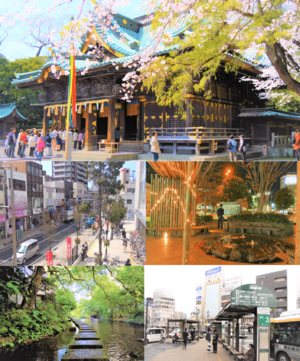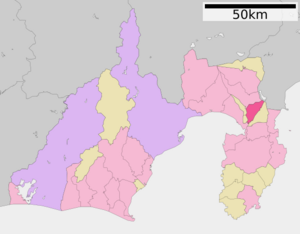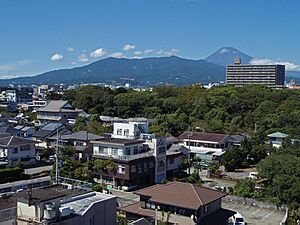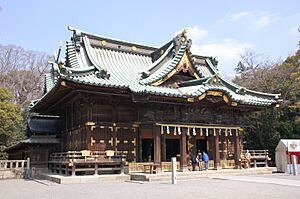Mishima, Shizuoka facts for kids
Quick facts for kids
Mishima
三島市
|
|||||||||||||
|---|---|---|---|---|---|---|---|---|---|---|---|---|---|

Mishima Taisha, Mishima Odori Shopping Street, Bamboo light, Genbei River, City center
|
|||||||||||||
|
|||||||||||||

Location of Mishima in Shizuoka Prefecture
|
|||||||||||||
| Country | |||||||||||||
| Region | Chūbu | ||||||||||||
| Prefecture | |||||||||||||
| First official recorded | 5th century AD | ||||||||||||
| City Settled | April 29, 1941 | ||||||||||||
| Area | |||||||||||||
| • Total | 62.02 km2 (23.95 sq mi) | ||||||||||||
| Population
(October 1, 2020)
|
|||||||||||||
| • Total | 107,851 | ||||||||||||
| • Density | 1,739/km2 (4,500/sq mi) | ||||||||||||
| Time zone | UTC+09:00 (JST) | ||||||||||||
| Postal code |
411-8666
|
||||||||||||
| Phone number | 055-975-3111 | ||||||||||||
| Address | 4–47 Kitatamachi, Mishima-shi, Shizuoka-ken |
||||||||||||
| Climate | Cfa | ||||||||||||
|
|||||||||||||
Mishima (三島市, Mishima-shi) is a city located in eastern Shizuoka Prefecture, Japan. It is home to about 109,803 people living in 49,323 households. The city covers an area of about 62 square kilometers (24 square miles).
Contents
Geography: Where Mishima Is Located
Mishima is in the far eastern part of Shizuoka Prefecture, Japan. It sits at the northern tip of the Izu Peninsula. The city is also nestled in the foothills of the famous Mount Fuji.
Neighboring Towns and Cities
Mishima shares its borders with several other places:
- In Kanagawa Prefecture:
- In Shizuoka Prefecture:
- Kannami
- Nagaizumi
- Numazu
- Susono
Population Changes Over Time
The number of people living in Mishima has stayed pretty steady in the last 25 years. Here's how the population has changed:
| Historical population | ||
|---|---|---|
| Year | Pop. | ±% |
| 1940 | 38,827 | — |
| 1950 | 54,516 | +40.4% |
| 1960 | 62,966 | +15.5% |
| 1970 | 78,141 | +24.1% |
| 1980 | 94,612 | +21.1% |
| 1990 | 105,418 | +11.4% |
| 2000 | 110,519 | +4.8% |
| 2010 | 111,823 | +1.2% |
Mishima's Climate
Mishima has a humid subtropical climate. This means it has hot summers and cool winters. It rains a lot throughout the year, especially from June to September.
- The average yearly temperature in Mishima is about 16.3 degrees Celsius (61.3 degrees Fahrenheit).
- The average yearly rainfall is about 1868.2 millimeters (73.5 inches). September is usually the wettest month.
- Temperatures are highest in August, around 27.3 degrees Celsius (81.1 degrees Fahrenheit).
- The coldest month is January, with temperatures around 5.9 degrees Celsius (42.6 degrees Fahrenheit).
| Climate data for Mishima (1991−2020 normals, extremes 1930−present) | |||||||||||||
|---|---|---|---|---|---|---|---|---|---|---|---|---|---|
| Month | Jan | Feb | Mar | Apr | May | Jun | Jul | Aug | Sep | Oct | Nov | Dec | Year |
| Record high °C (°F) | 24.7 (76.5) |
24.8 (76.6) |
26.7 (80.1) |
28.7 (83.7) |
31.4 (88.5) |
36.5 (97.7) |
36.6 (97.9) |
37.4 (99.3) |
36.7 (98.1) |
32.9 (91.2) |
27.8 (82.0) |
25.2 (77.4) |
37.4 (99.3) |
| Mean daily maximum °C (°F) | 11.5 (52.7) |
12.4 (54.3) |
15.3 (59.5) |
19.9 (67.8) |
23.9 (75.0) |
26.5 (79.7) |
30.2 (86.4) |
31.8 (89.2) |
28.6 (83.5) |
23.5 (74.3) |
18.6 (65.5) |
13.9 (57.0) |
21.3 (70.4) |
| Daily mean °C (°F) | 5.9 (42.6) |
6.8 (44.2) |
10.0 (50.0) |
14.6 (58.3) |
19.0 (66.2) |
22.3 (72.1) |
26.0 (78.8) |
27.3 (81.1) |
24.0 (75.2) |
18.5 (65.3) |
13.2 (55.8) |
8.2 (46.8) |
16.3 (61.4) |
| Mean daily minimum °C (°F) | 0.8 (33.4) |
1.5 (34.7) |
4.8 (40.6) |
9.5 (49.1) |
14.3 (57.7) |
18.7 (65.7) |
22.8 (73.0) |
23.7 (74.7) |
20.1 (68.2) |
14.2 (57.6) |
8.4 (47.1) |
3.1 (37.6) |
11.8 (53.3) |
| Record low °C (°F) | −9.2 (15.4) |
−9.8 (14.4) |
−7.8 (18.0) |
−2.4 (27.7) |
1.1 (34.0) |
7.9 (46.2) |
11.6 (52.9) |
15.4 (59.7) |
8.4 (47.1) |
0.9 (33.6) |
−2.5 (27.5) |
−7.8 (18.0) |
−9.8 (14.4) |
| Average precipitation mm (inches) | 73.2 (2.88) |
91.6 (3.61) |
154.9 (6.10) |
152.8 (6.02) |
158.7 (6.25) |
212.7 (8.37) |
223.4 (8.80) |
168.5 (6.63) |
241.8 (9.52) |
215.7 (8.49) |
110.7 (4.36) |
65.1 (2.56) |
1,868.2 (73.55) |
| Average snowfall cm (inches) | 0 (0) |
2 (0.8) |
0 (0) |
0 (0) |
0 (0) |
0 (0) |
0 (0) |
0 (0) |
0 (0) |
0 (0) |
0 (0) |
0 (0) |
2 (0.8) |
| Average precipitation days (≥ 1.0 mm) | 5.8 | 6.3 | 10.4 | 10.0 | 9.8 | 11.7 | 10.5 | 8.3 | 10.8 | 10.1 | 7.7 | 6.1 | 107.5 |
| Average snowy days (≥ 1 cm) | 0 | 0.5 | 0 | 0 | 0 | 0 | 0 | 0 | 0 | 0 | 0 | 0 | 0.5 |
| Average relative humidity (%) | 65 | 63 | 65 | 67 | 70 | 75 | 76 | 74 | 75 | 74 | 73 | 68 | 70 |
| Mean monthly sunshine hours | 186.3 | 168.1 | 172.2 | 182.2 | 184.8 | 128.9 | 149.7 | 191.0 | 151.2 | 149.4 | 160.1 | 179.4 | 2,003.2 |
| Source: Japan Meteorological Agency | |||||||||||||
History: Mishima's Past
Mishima is a very old town with a rich history. It grew up around the important Shinto shrine called Mishima Taisha.
Early Beginnings
- In ancient times, during the Nara period, Mishima was chosen as the capital of Izu Province.
- It was also home to the Kokubun-ji, a special temple for Izu Province.
- During the Edo period, Mishima became a busy stop on the Tōkaidō highway. This road connected the big cities of Edo (now Tokyo) and Kyoto.
- Mishima-shuku was one of the 53 shukuba (post stations) where travelers could rest.
Modern Development
- After the Meiji Restoration (a big change in Japan's government), Mishima became part of Shizuoka Prefecture in 1876.
- In 1892, Prince Komatsu Akihito built a beautiful villa in Mishima. Its gardens, called Rakujūen, are still a popular place to visit today.
- Mishima got its first train connection in 1898.
- The town really started to grow after the Tanna Tunnel was finished in 1934. This tunnel connected Mishima to the main railway line between Tokyo and Shizuoka.
- Mishima officially became a city on April 29, 1941.
- When the Tōkaidō Shinkansen (bullet train) started stopping in Mishima in 1969, even more people moved there. It made it easy for people to travel to Tokyo for work or school.
Economy: What Mishima Makes
Mishima is an important industrial center in Shizuoka Prefecture. It has several factories and businesses:
- JR Central has a facility here that repairs trains.
- Other companies like Toray, DMW Corporation, Toshiba TEC Corporation, and Yokohama Rubber Company also have factories in Mishima.
- The Izuhakone Railway Company Ltd. is also based here.
Education: Schools and Universities
Mishima has many schools for students of all ages:
- There are 14 public elementary schools.
- There are seven public middle schools.
- The Shizuoka Prefectural Board of Education runs three public high schools.
- Mishima also has private schools, including one junior high school and two high schools.
- For higher education, Juntendo University and the Graduate University for Advanced Studies have facilities in Mishima.
- The College of International Relations for Nihon University is also located in the city.
Sister Cities: Friends Around the World
Mishima has special relationships with cities in other countries. These are called "sister cities":
 Pasadena, California, United States (since July 24, 1957)
Pasadena, California, United States (since July 24, 1957) New Plymouth, New Zealand (since April 29, 1991)
New Plymouth, New Zealand (since April 29, 1991) Lishui, Zhejiang, China (since May 12, 1997)
Lishui, Zhejiang, China (since May 12, 1997)
Transport: Getting Around Mishima
Mishima is well-connected by trains and highways.
Railway Lines
 Central Japan Railway Company – Tōkaidō Shinkansen (Bullet Train)
Central Japan Railway Company – Tōkaidō Shinkansen (Bullet Train)
- Mishima
 Central Japan Railway Company – Tōkaidō Main Line
Central Japan Railway Company – Tōkaidō Main Line
- Mishima Station
 Izuhakone Railway – Sunzu Line
Izuhakone Railway – Sunzu Line
- Mishima – Mishima-Hirokōji – Mishima-Tamachi – Mishima-Futsukamachi – Daiba
Major Highways
 Tōmei Expressway
Tōmei Expressway Shin-Tōmei Expressway
Shin-Tōmei Expressway Izu-Jūkan Expressway
Izu-Jūkan Expressway National Route 1
National Route 1 National Route 136
National Route 136
Local Attractions: Fun Things to See and Do
Mishima offers many interesting places to visit and fun events:
- Mishima Taisha: A very old and important Shinto shrine.
- Ryūtaku-ji Rinzai Zen temple: A peaceful Buddhist temple.
- Izu Kokubun-ji ruins: The remains of an ancient provincial temple, now a National Historic Site.
- Yamanaka Castle ruins: The ruins of an old castle, also a National Historic Site.
- Sano Art Museum: A museum showcasing various artworks.
- Rakuju-en Gardens: Beautiful gardens that were once part of a prince's villa.
- The Mishima Summer Festival: A lively festival that takes place every year from August 15 to 17.
Notable People from Mishima
Many talented people come from Mishima, including:
- EVIL (Takaaki Watanabe): A Japanese professional wrestler.
- Sagatsukasa Hiroyuki (Hiroyuki Isobe): A sumo wrestler.
- Makoto Ōoka: A famous poet and literary critic.
- Naohiro Takahara: A professional soccer player.
- Yoshiaki Koizumi: A video game designer and producer for Nintendo.
- Tomomi Takahashi: A baseball player.
- Hikari Takagi: A professional women's soccer player for the Japan national team.
See also
 In Spanish: Mishima (Shizuoka) para niños
In Spanish: Mishima (Shizuoka) para niños







